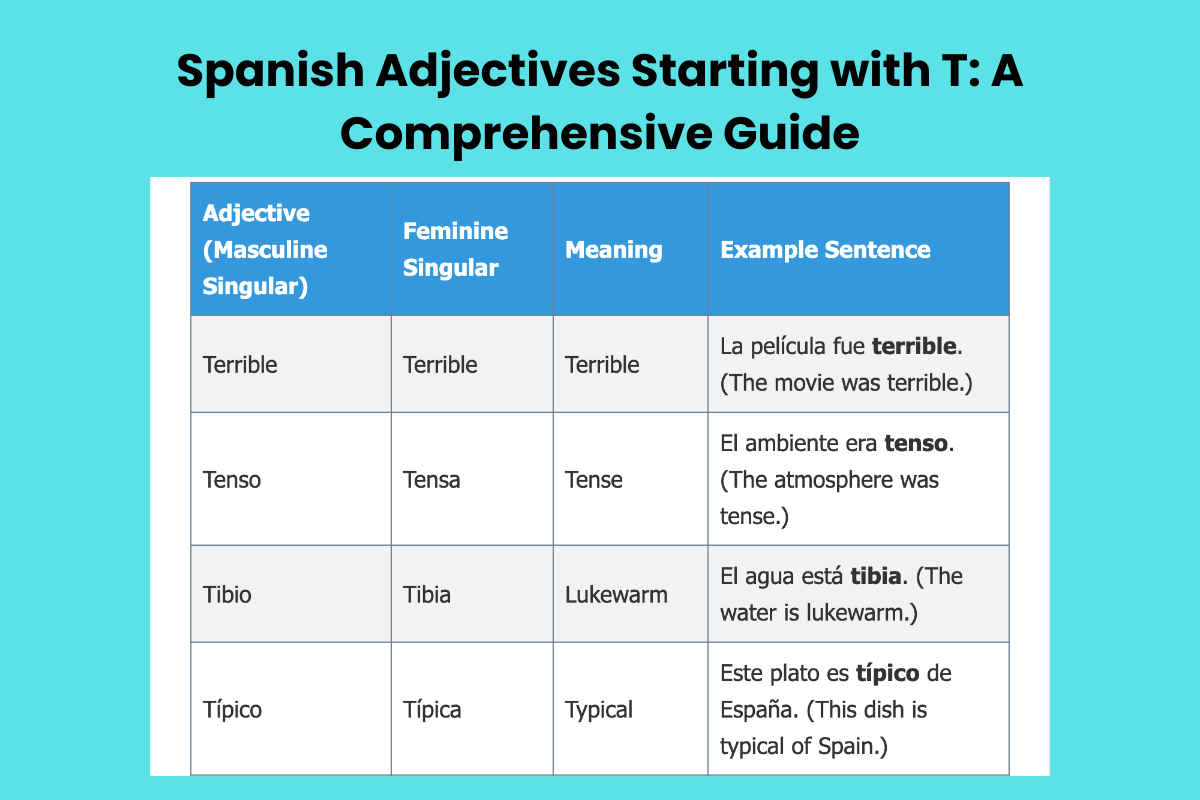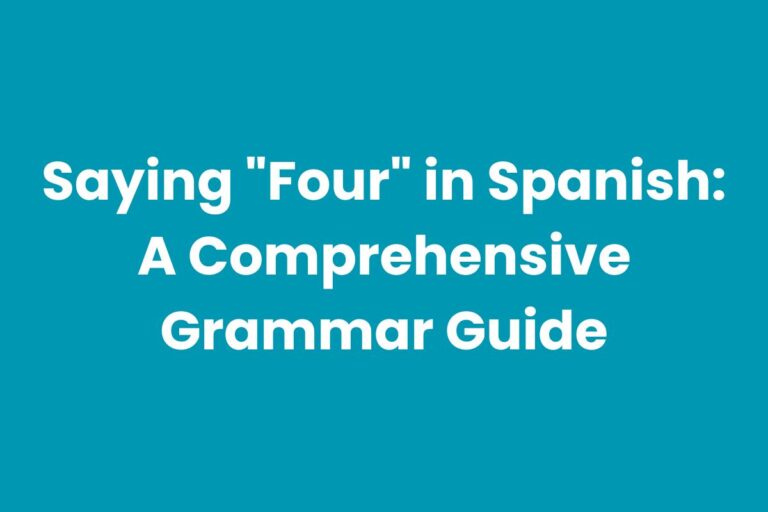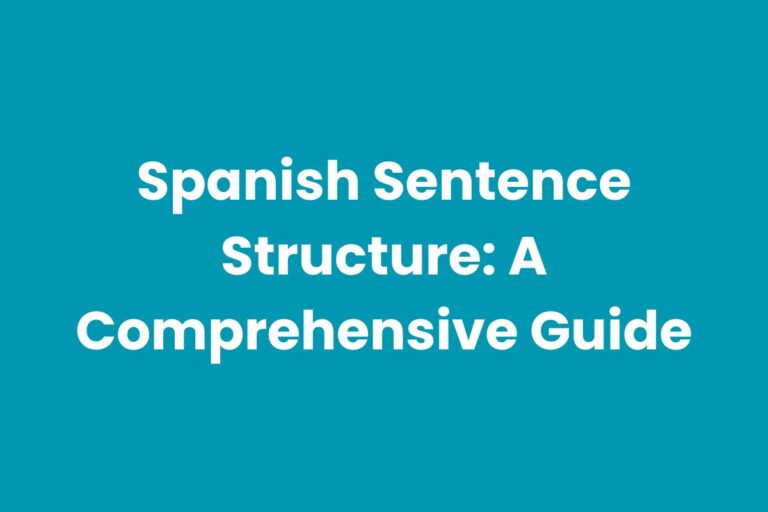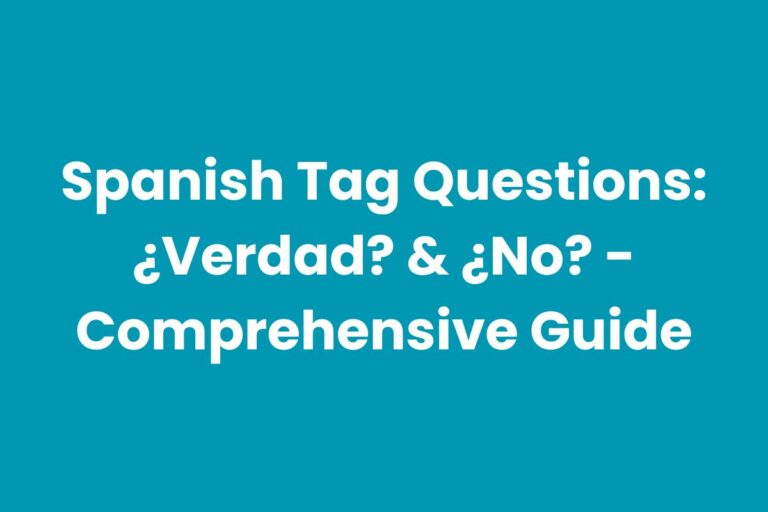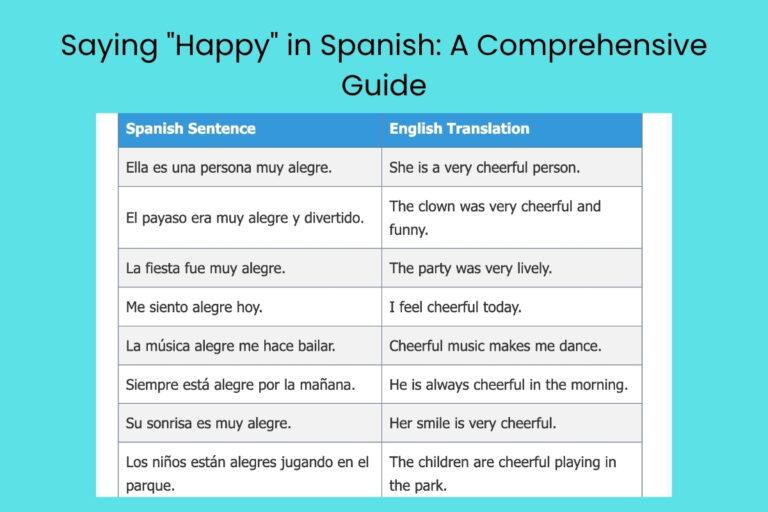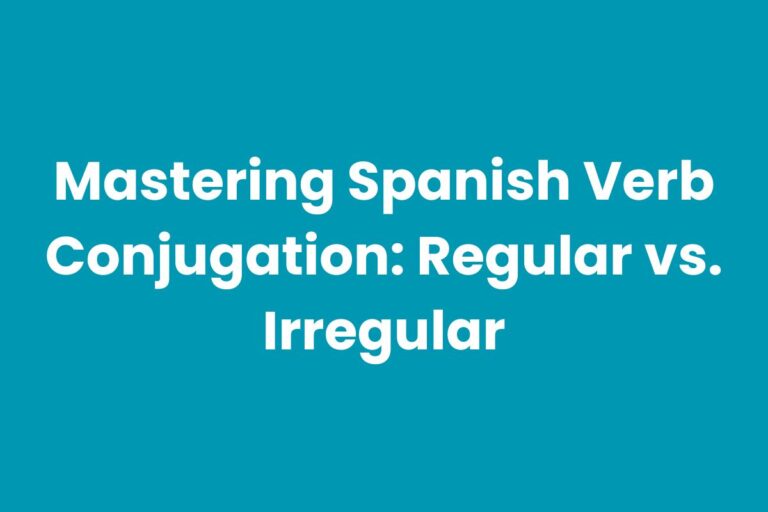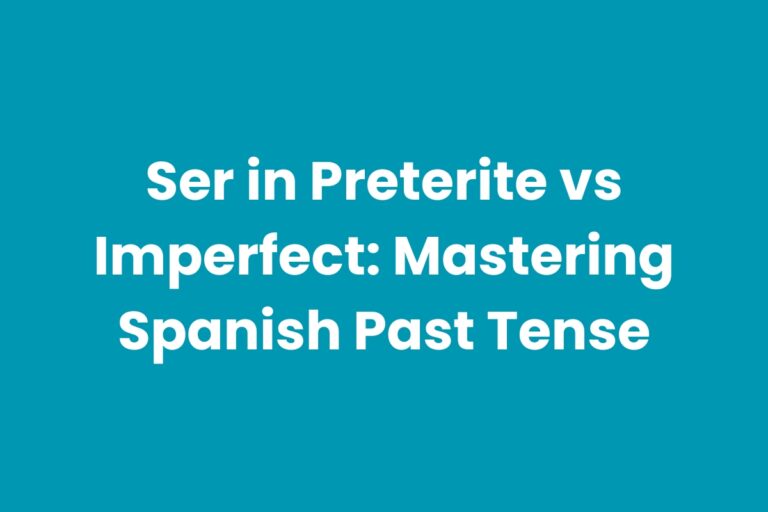Spanish Adjectives Starting with T: A Comprehensive Guide
Understanding adjectives is crucial for building descriptive and nuanced sentences in any language. In Spanish, adjectives modify nouns, providing details about their characteristics, qualities, or states.
This article focuses specifically on Spanish adjectives that begin with the letter “T,” offering a comprehensive guide to their meanings, usage, and grammatical considerations. Mastering these adjectives will significantly enhance your ability to express yourself effectively and accurately in Spanish.
This guide is beneficial for students of all levels, from beginners seeking to expand their vocabulary to advanced learners aiming to refine their linguistic skills.
Table of Contents
- Introduction
- Definition of Spanish Adjectives
- Structural Breakdown
- Types and Categories of Spanish Adjectives Starting with T
- Examples of Spanish Adjectives Starting with T
- Usage Rules for Spanish Adjectives
- Common Mistakes
- Practice Exercises
- Advanced Topics
- FAQ
- Conclusion
Definition of Spanish Adjectives
In Spanish grammar, an adjective (adjetivo) is a word that modifies a noun (sustantivo) or pronoun, providing additional information about it. Adjectives describe the qualities, characteristics, or states of the noun they modify. They agree in gender (masculine or feminine) and number (singular or plural) with the noun they describe. Adjectives enrich our language allowing us to create vivid and detailed descriptions.
The primary function of an adjective is to provide more specific information about a noun. This information can relate to color, size, shape, origin, or any other attribute. For example, in the phrase “el coche rojo” (the red car), the adjective “rojo” (red) describes the color of the car. Understanding and using adjectives correctly is essential for clear and effective communication in Spanish.
Adjectives can appear in different contexts, such as descriptive writing, conversations, and formal documents. Their proper use enhances clarity and allows for more precise expression. Furthermore, the placement of adjectives in relation to the nouns they modify can sometimes change the meaning of the sentence, a nuance that advanced learners need to master. For example, “un hombre pobre” (a poor man) describes a man with little money, while “un pobre hombre” (a pitiful man) describes a man who is unfortunate.
Structural Breakdown
The structure of Spanish adjectives is relatively straightforward, but understanding the agreement rules is crucial. Adjectives must agree in both gender and number with the nouns they modify.
This means that if the noun is masculine singular, the adjective must also be masculine singular. Similarly, if the noun is feminine plural, the adjective must also be feminine plural.
Most Spanish adjectives have four forms: masculine singular, feminine singular, masculine plural, and feminine plural. The masculine singular form is often considered the base form.
To form the feminine singular, you typically change the “-o” ending to “-a.” To form the plural, you add “-s” to adjectives ending in a vowel and “-es” to adjectives ending in a consonant. However, there are exceptions and irregular forms to consider.
Here’s a breakdown of the typical adjective formation rules:
- Masculine Singular: This is the base form of the adjective (e.g., alto – tall).
- Feminine Singular: Typically formed by changing “-o” to “-a” (e.g., alta – tall).
- Masculine Plural: Typically formed by adding “-s” to adjectives ending in a vowel or “-es” to adjectives ending in a consonant (e.g., altos – tall).
- Feminine Plural: Typically formed by adding “-s” to the feminine singular form (e.g., altas – tall).
For adjectives that end in “-e,” “-ista,” or a consonant, the masculine and feminine singular forms are the same. The plural is formed by adding “-s” or “-es” as appropriate.
Understanding these basic rules is essential for correct adjective usage.
Types and Categories of Spanish Adjectives Starting with T
Spanish adjectives starting with “T” can be categorized in several ways, depending on the type of characteristic they describe. Here, we will examine three main categories: descriptive adjectives, adjectives of nationality, and adjectives of personality.
Descriptive Adjectives
Descriptive adjectives provide information about the physical characteristics, qualities, or states of nouns. These adjectives are commonly used to paint a vivid picture and provide detailed information. Examples include tranquilo (calm), típico (typical), and tormentoso (stormy).
Adjectives of Nationality
Adjectives of nationality indicate the origin or nationality of a person, place, or thing. These adjectives are often derived from the name of a country or region. Examples include tailandés (Thai) and turco (Turkish).
Adjectives of Personality
Adjectives of personality describe the character, behavior, or emotional state of individuals. These adjectives can be used to express opinions or judgments about someone’s personality. Examples include tímido (shy), testarudo (stubborn), and tolerante (tolerant).
Examples of Spanish Adjectives Starting with T
This section provides extensive examples of Spanish adjectives that start with the letter “T,” categorized for clarity and ease of understanding. Each table includes a wide range of adjectives with their meanings and example sentences.
Descriptive Adjectives
The following table presents a variety of descriptive adjectives starting with “T,” along with their meanings and example sentences to illustrate their usage.
| Adjective (Masculine Singular) | Feminine Singular | Meaning | Example Sentence |
|---|---|---|---|
| Terrible | Terrible | Terrible | La película fue terrible. (The movie was terrible.) |
| Tenso | Tensa | Tense | El ambiente era tenso. (The atmosphere was tense.) |
| Tibio | Tibia | Lukewarm | El agua está tibia. (The water is lukewarm.) |
| Típico | Típica | Typical | Este plato es típico de España. (This dish is typical of Spain.) |
| Tormentoso | Tormentosa | Stormy | El clima está tormentoso. (The weather is stormy.) |
| Total | Total | Total | Hay un control total. (There is total control.) |
| Tranquilo | Tranquila | Calm | El mar está tranquilo hoy. (The sea is calm today.) |
| Triste | Triste | Sad | Estoy triste hoy. (I am sad today.) |
| Tropical | Tropical | Tropical | La fruta es tropical. (The fruit is tropical.) |
| Turbio | Turbia | Cloudy | El agua está turbia. (The water is cloudy.) |
| Tierno | Tierna | Tender | La carne es muy tierna. (The meat is very tender.) |
| Trasero | Trasera | Rear | La puerta trasera está cerrada. (The rear door is closed.) |
| Tardío | Tardía | Late | El vuelo sufrió un retraso tardío. (The flight suffered a late delay.) |
| Temprano | Temprana | Early | La salida temprana fue cancelada. (The early departure was cancelled.) |
| Tenebroso | Tenebrosa | Dark/Gloomy | El bosque parece tenebroso de noche. (The forest seems dark at night.) |
| Textual | Textual | Textual | La cita es textual. (The quote is textual.) |
| Teórico | Teórica | Theoretical | El concepto es teórico. (The concept is theoretical.) |
| Terminado | Terminada | Finished | La obra está terminada. (The work is finished.) |
| Testado | Testada | Tested | El producto está testado. (The product is tested.) |
| Texturizado | Texturizada | Textured | El muro está texturizado. (The wall is textured.) |
| Titánico | Titánica | Titanic | La tarea es titánica. (The task is titanic.) |
| Tolerable | Tolerable | Tolerable | El dolor es tolerable. (The pain is tolerable.) |
| Tónico | Tónica | Tonic | La bebida es tónica. (The drink is tonic.) |
| Topográfico | Topográfica | Topographic | El mapa es topográfico. (The map is topographic.) |
Adjectives of Nationality
This table provides examples of adjectives of nationality starting with “T,” demonstrating how to describe someone’s origin.
| Adjective (Masculine Singular) | Feminine Singular | Meaning | Example Sentence |
|---|---|---|---|
| Tailandés | Tailandesa | Thai | El restaurante es tailandés. (The restaurant is Thai.) |
| Taiwanés | Taiwanesa | Taiwanese | El té es taiwanés. (The tea is Taiwanese.) |
| Tanzano | Tanzana | Tanzanian | El café es tanzano. (The coffee is Tanzanian.) |
| Tayiko | Tayika | Tajik | La cultura es tayika. (The culture is Tajik.) |
| Togoés | Togolesa | Togolese | La comida es togolesa. (The food is Togolese.) |
| Turco | Turca | Turkish | El café es turco. (The coffee is Turkish.) |
| Tunecino | Tunecina | Tunisian | La música es tunecina. (The music is Tunisian.) |
| Turcomano | Turcomana | Turkmen | La alfombra es turcomana. (The carpet is Turkmen.) |
| Tibetano | Tibetana | Tibetan | El monasterio es tibetano. (The monastery is Tibetan.) |
| Trinitense | Trinitense | Trinidadian | La música es trinitense. (The music is Trinidadian.) |
| Timorense | Timorense | Timorese | La artesanía es timorense. (The handicraft is Timorese.) |
| Tongano | Tongana | Tongan | La danza es tongana. (The dance is Tongan.) |
| Togolés | Togolesa | Togolese | La comida es togolesa. (The food is Togolese.) |
| Tuvaluano | Tuvaluana | Tuvaluan | La cultura es tuvaluana. (The culture is Tuvaluan.) |
Adjectives of Personality
This table showcases adjectives of personality that begin with “T,” useful for describing character traits and behaviors.
| Adjective (Masculine Singular) | Feminine Singular | Meaning | Example Sentence |
|---|---|---|---|
| Tímido | Tímida | Shy | Él es muy tímido. (He is very shy.) |
| Testarudo | Testaruda | Stubborn | Ella es testaruda a veces. (She is stubborn sometimes.) |
| Trabajador | Trabajadora | Hardworking | Él es un hombre trabajador. (He is a hardworking man.) |
| Tolerante | Tolerante | Tolerant | Es una persona tolerante. (He/She is a tolerant person.) |
| Torpe | Torpe | Clumsy | Soy un poco torpe. (I am a bit clumsy.) |
| Tranquilo | Tranquila | Calm | Él es muy tranquilo. (He is very calm.) |
| Travieso | Traviesa | Mischievous | El niño es travieso. (The boy is mischievous.) |
| Tenaz | Tenaz | Tenacious | Es una persona tenaz. (He/She is a tenacious person.) |
| Transigente | Transigente | Accommodating | El jefe es transigente. (The boss is accommodating.) |
| Taciturno | Taciturna | Taciturn | El hombre es taciturno. (The man is taciturn.) |
Usage Rules for Spanish Adjectives
Several rules govern the proper usage of Spanish adjectives. The most crucial rule is agreement in gender and number with the noun they modify.
Here’s a breakdown of the key rules:
- Gender Agreement: Adjectives must match the gender of the noun. Masculine nouns require masculine adjectives, and feminine nouns require feminine adjectives.
- Number Agreement: Adjectives must match the number of the noun. Singular nouns require singular adjectives, and plural nouns require plural adjectives.
- Adjective Placement: In Spanish, adjectives typically follow the noun they modify. However, certain adjectives can precede the noun, often changing the meaning or emphasis.
- Exceptions: Some adjectives have irregular forms or do not change based on gender. These exceptions must be memorized.
Let’s look at some examples illustrating these rules:
- El libro interesante (The interesting book) – Masculine singular noun and adjective.
- La casa bonita (The beautiful house) – Feminine singular noun and adjective.
- Los libros interesantes (The interesting books) – Masculine plural noun and adjective.
- Las casas bonitas (The beautiful houses) – Feminine plural noun and adjective.
Adjective placement can also affect meaning. For example:
- Un hombre pobre (A poor man – with little money)
- Un pobre hombre (A pitiful man)
Understanding these rules and exceptions is vital for using Spanish adjectives correctly and effectively.
Common Mistakes
Learners often make common mistakes when using Spanish adjectives. These mistakes usually involve incorrect gender or number agreement, or improper adjective placement.
Here are some examples of common errors and their corrections:
| Incorrect | Correct | Explanation |
|---|---|---|
| El casa bonita | La casa bonita | “Casa” is feminine, so the adjective must be “bonita.” |
| Las libro interesantes | Los libros interesantes | “Libro” is masculine, and it’s plural so the adjective must be “interesantes.” |
| Un hombre pobre (meaning a pitiful man) | Un pobre hombre | The position changes the meaning. |
| Una persona tranquilos | Una persona tranquila | “Persona” is singular and feminine, thus the adjective must be singular and feminine. |
By being aware of these common mistakes, learners can avoid errors and improve their accuracy in using Spanish adjectives.
Practice Exercises
These practice exercises will help you reinforce your understanding of Spanish adjectives starting with “T.” Each exercise focuses on different aspects of adjective usage, including gender and number agreement, and sentence construction.
Exercise 1: Fill in the Blanks
Complete the following sentences with the correct form of the adjective provided in parentheses.
| Question | Answer |
|---|---|
| 1. La niña es muy ________ (tímido). | 1. La niña es muy tímida. |
| 2. Los libros son ________ (interesante). | 2. Los libros son interesantes. |
| 3. El clima es ________ (tropical). | 3. El clima es tropical. |
| 4. Las flores son ________ (bonito). | 4. Las flores son bonitas. |
| 5. El hombre es ________ (trabajador). | 5. El hombre es trabajador. |
| 6. La comida es ________ (típico) de España. | 6. La comida es típica de España. |
| 7. Los estudiantes son ________ (inteligente). | 7. Los estudiantes son inteligentes. |
| 8. La casa es ________ (grande). | 8. La casa es grande. |
| 9. El día está ________ (tormentoso). | 9. El día está tormentoso. |
| 10. Las personas son ________ (tolerante). | 10. Las personas son tolerantes. |
Exercise 2: Correct the Errors
Identify and correct the errors in the following sentences.
| Question | Answer |
|---|---|
| 1. El casa es bonita. | 1. La casa es bonita. |
| 2. Los niño son traviesa. | 2. Los niños son traviesos. |
| 3. La libro interesante. | 3. El libro interesante. |
| 4. Las persona tranquilo. | 4. Las personas tranquilas. |
| 5. Un hombre testaruda. | 5. Un hombre testarudo. |
| 6. Los clima tropical. | 6. El clima tropical. |
| 7. La agua turbio. | 7. El agua turbia. |
| 8. Un día tormentosa. | 8. Un día tormentoso. |
| 9. Las café turcas. | 9. El café turco. |
| 10. El mujer tenaz. | 10. La mujer tenaz. |
Exercise 3: Sentence Construction
Use the given adjectives to create original sentences in Spanish.
| Adjective | Example Sentence |
|---|---|
| 1. Terrible | 1. La situación es terrible. |
| 2. Típico | 2. Este baile es típico de la región. |
| 3. Tranquilo | 3. El pueblo es tranquilo y pacífico. |
| 4. Testarudo | 4. Mi hermano es muy testarudo. |
| 5. Tailandés | 5. Me encanta la comida tailandesa. |
| 6. Total | 6. Hay un control total sobre el proyecto. |
| 7. Tenaz | 7. Ella es una atleta muy tenaz. |
| 8. Tropical | 8. Las frutas tropicales son deliciosas. |
| 9. Turco | 9. El baño turco es muy relajante. |
| 10. Tibio | 10. El agua está tibia, perfecta para nadar. |
Advanced Topics
For advanced learners, there are more complex aspects of adjective usage to consider. These include:
- Superlative Forms: Forming superlative adjectives using “-ísimo/a” or phrases like “el/la más…”
- Adjective Clauses: Using relative pronouns to create complex sentences with descriptive clauses.
- Subjunctive Mood: Using adjectives in clauses that require the subjunctive mood.
For example, to form the superlative of “tranquilo,” you can say “tranquilísimo” (very calm). In a clause using the subjunctive mood: “Busco un libro que sea interesante” (I am looking for a book that is interesting).
Mastering these advanced topics will significantly enhance your fluency and accuracy in Spanish.
FAQ
Here are some frequently asked questions about Spanish adjectives:
- Q: Do all Spanish adjectives change based on gender and number?
A: No, some adjectives, particularly those ending in “-e” or a consonant, only change for number. - Q: Where are adjectives typically placed in a Spanish sentence?
A: Adjectives usually follow the noun they modify, but some can precede the noun, often changing the meaning. - Q: How do I form the plural of an adjective ending in “-z”?
A: Change the “-z” to “-ces” (e.g., feliz becomes felices). - Q: What are some common exceptions to the adjective agreement rules?
A: Adjectives of nationality ending in “-és” add “-a” for the feminine form (e.g., inglés, inglesa). - Q: How can I improve my adjective usage in Spanish?
A: Practice regularly, read Spanish texts, and pay attention to how native speakers use adjectives. - Q: Are there any adjectives that are always placed before the noun?
A: Yes, some adjectives like “bueno” (good) and “malo” (bad) often precede the noun, especially in informal speech. - Q: How do I use multiple adjectives to describe a noun?
A: Place the adjectives after the noun, separated by commas or the conjunction “y” (and). For example, “la casa grande y bonita” (the big and beautiful house). - Q: What is the difference between a descriptive adjective and a limiting adjective?
A: Descriptive adjectives provide qualities or characteristics, while limiting adjectives specify quantity, possession, or identification. Examples of limiting adjectives include demonstrative adjectives (este, ese, aquel) and possessive adjectives (mi, tu, su). - Q: How do I form comparative adjectives in Spanish?
A: Use “más” (more) or “menos” (less) before the adjective, followed by “que” (than). For example, “más alto que” (taller than). - Q: What are some resources for learning more about Spanish adjectives?
A: Online grammar websites, Spanish textbooks, language exchange partners, and immersion programs are all valuable resources.
Conclusion
Mastering Spanish adjectives, particularly those starting with the letter “T,” is essential for building a rich and expressive vocabulary. Understanding the rules of gender and number agreement, adjective placement, and common exceptions will greatly improve your accuracy and fluency.
By studying the examples provided, practicing the exercises, and reviewing the frequently asked questions, you can confidently use these adjectives in your Spanish communication.
Remember to practice consistently and immerse yourself in the language through reading, listening, and speaking. Pay attention to how native speakers use adjectives in various contexts, and don’t be afraid to make mistakes – they are a natural part of the learning process.
With dedication and practice, you will master the nuances of Spanish adjectives and enhance your overall language proficiency.

